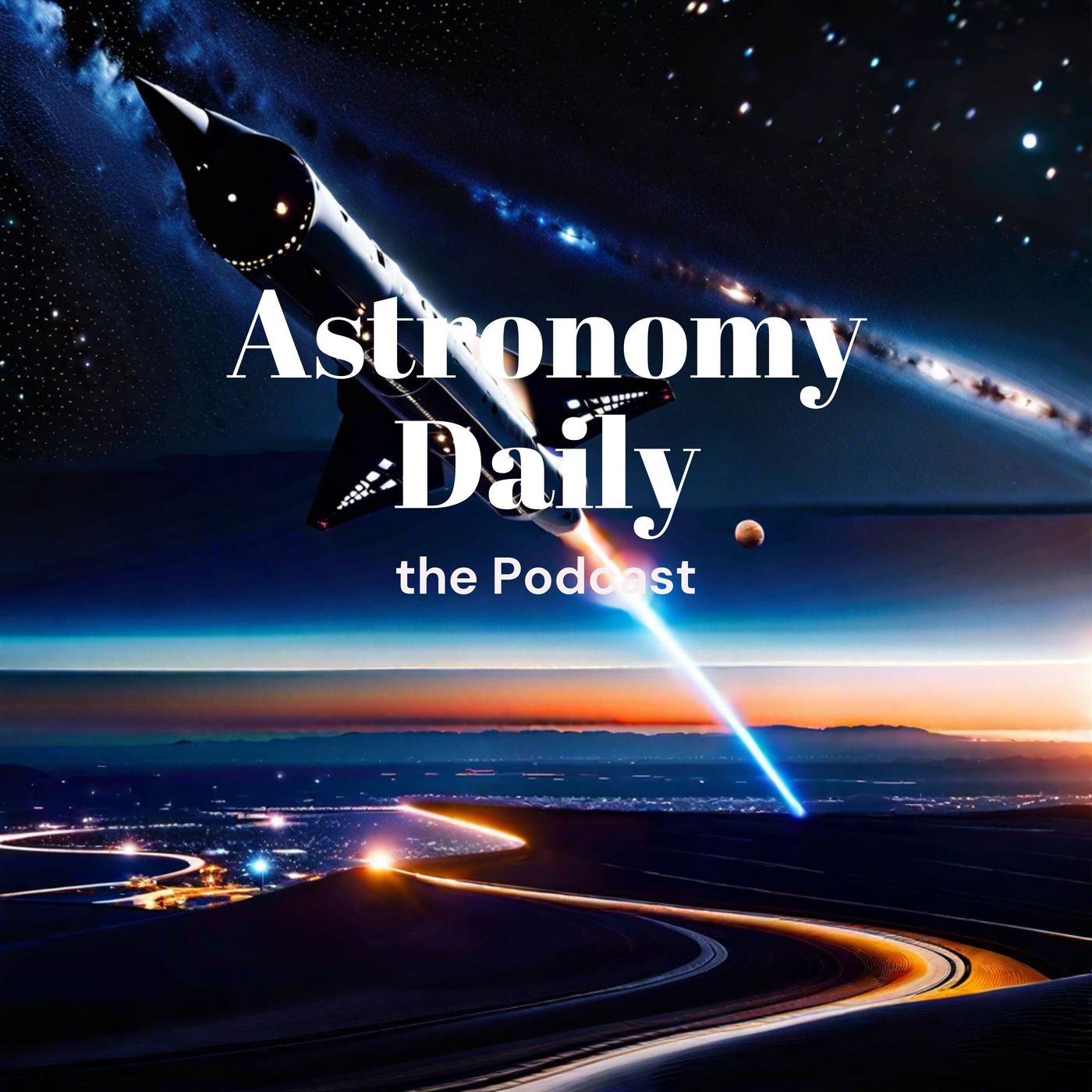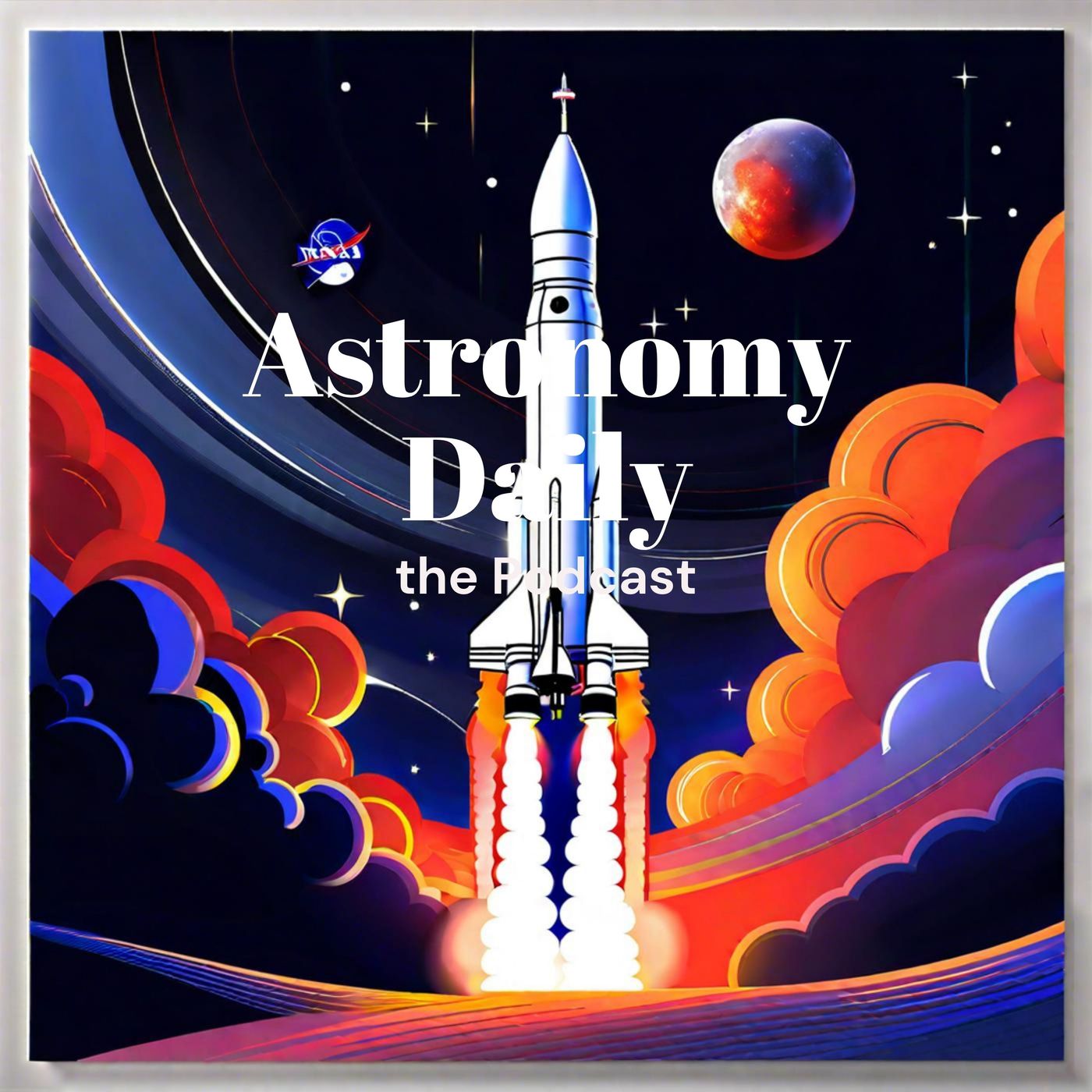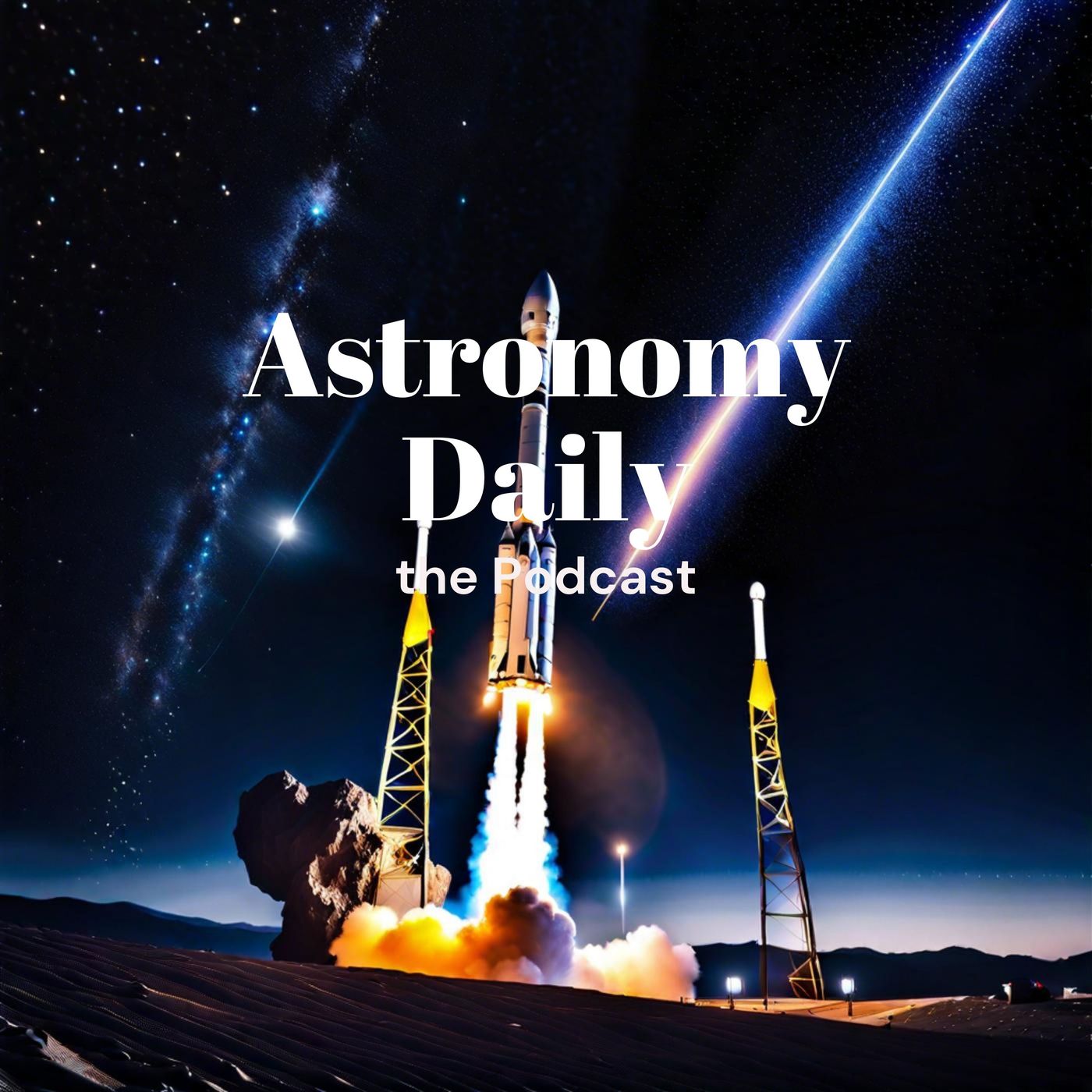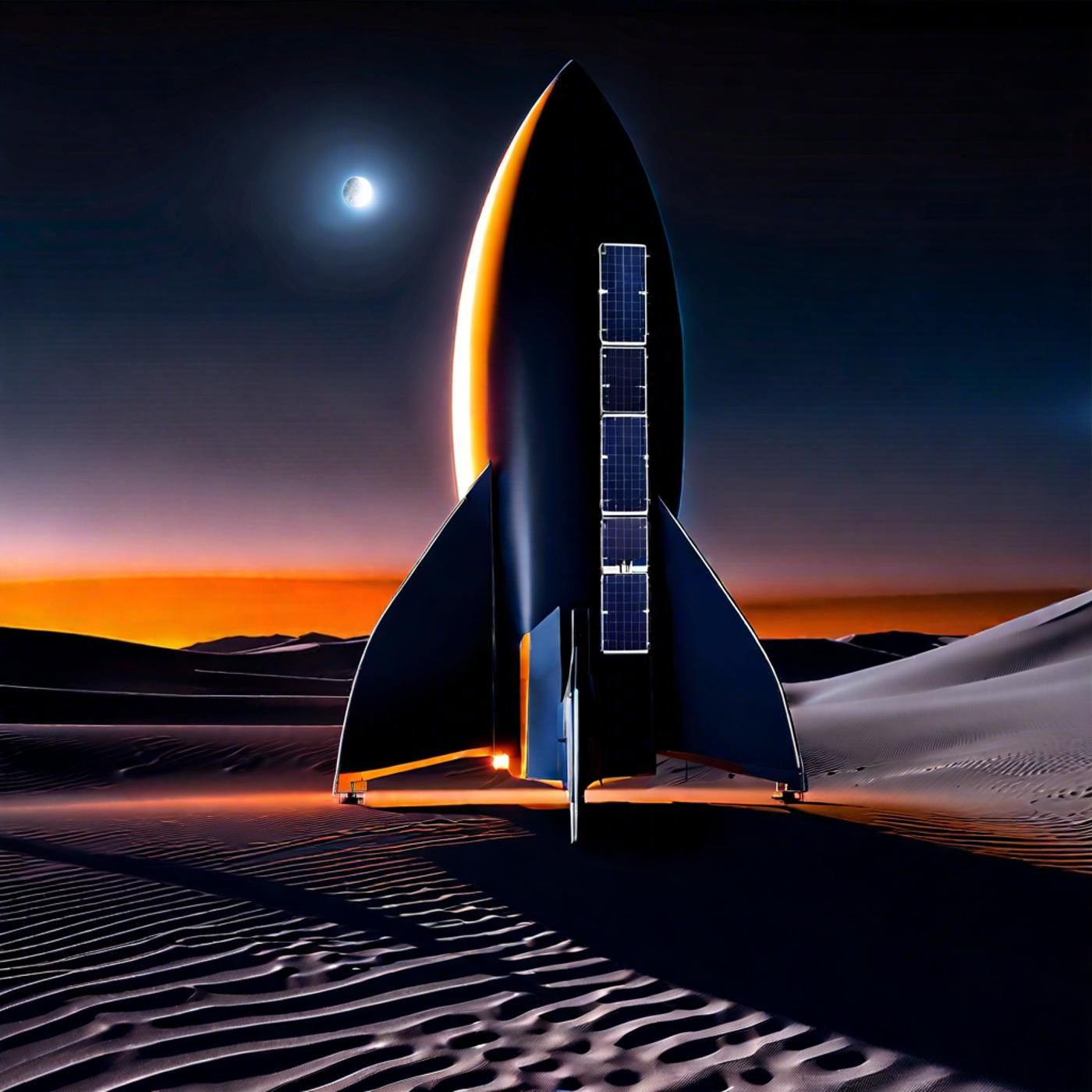S04E100: Falcon 9's Rare Failure & Apollo 11's 55th Anniversary
Welcome to Astronomy Daily, your ultimate source for the latest and most captivating news in space and astronomy. I'm Anna, your host, and I'm excited to guide you through today's cosmic happenings. Whether you're a seasoned stargazer or a newcomer to...
Welcome to Astronomy Daily, your ultimate source for the latest and most captivating news in space and astronomy. I'm Anna, your host, and I'm excited to guide you through today's cosmic happenings. Whether you're a seasoned stargazer or a newcomer to the wonders of the universe, this podcast promises to be both engaging and insightful. Today, we're diving into some fascinating developments, from the unexpected hiccup with SpaceX's Falcon 9 rocket, which has been a stalwart in the launch industry, to NASA's celebration of the Apollo 11 moon landing's 55th anniversary, highlighting how Apollo-era innovations continue to influence today's space missions. We'll also celebrate the second anniversary of the James Webb Space Telescope, marveling at its latest stunning images and groundbreaking discoveries. Finally, we'll discuss the concerns surrounding the Europa Clipper mission, focusing on some technical issues that have emerged just months before its anticipated launch. So sit back, relax, and let's explore the universe together.
Episode Highlights
- SpaceX Falcon 9 Rocket Failure: Last Friday, SpaceX's Falcon 9 rocket faced a rare and unfortunate failure, marking the end of an impressive seven-year success streak. This incident involved the rocket breaking apart in space, which doomed its payload of 20 Starlink satellites. The investigation into the cause of this engine failure has already begun, and the Falcon 9 will remain grounded until a comprehensive solution is found.
- Apollo 11 Moon Landing 55th Anniversary: NASA is gearing up to celebrate a monumental milestone in space exploration, the 55th anniversary of the Apollo 11 moon landing. This landmark event took place on July 20, 1969, when astronauts Neil Armstrong and Buzz Aldrin became the first humans to set foot on the moon. To honor this remarkable achievement, NASA has planned a series of in-person, virtual, and engagement activities across the nation from July 15 to July 25.
- James Webb Space Telescope 2nd Anniversary: The James Webb Space Telescope has just marked its second anniversary of operations. Since its launch, the Webb telescope has continued to astonish us with its groundbreaking discoveries and captivating images. The anniversary image depicts the cosmic ballet of interacting galaxies, Arp 142, captured in vivid detail by Webb's near-infrared camera and mid-infrared instrument.
- Europa Clipper Mission Concerns: The highly anticipated Europa Clipper mission, set to illuminate the mysteries of Jupiter's icy moon Europa, faces a significant hurdle just months before its planned launch in October. A newly discovered problem with the spacecraft's transistors has thrown a wrench in the mission's timeline. This ambitious $5 billion endeavor aims to assess the moon's potential to support life.
Don't forget to visit our website for more episodes and the latest space news from our continually updating news feed. For even more space content and updates, follow us on Facebook, X, and TikTok. Until next time, keep looking up and stay curious about the universe.
Become a supporter of this podcast: Support Astronomy Daily.
Check our unmissable sponsor deal from Malwarebytes - for a limited time get all the protection you need for 50% off! But this is a limited-time offer. For details, visit www.bitesz.com/malwarebytes.
www.bitesz.com
This podcast features the latest and most interesting news in space and astronomy
Anna: Welcome to Astronomy Daily, your ultimate source for the latest and most captivating news in space and Astronomy. I'm Anna, your host, and I'm excited to guide you through today's cosmic happenings. Whether you're a seasoned stargazer or a newcomer to the wonders of the universe, this podcast promises to be both engaging and insightful. Today, we're diving into some fascinating developments, from the unexpected hiccup with SpaceX's Falcon Nine rocket, which has been a stalwart in the launch industry, to NASA's celebration of the Apollo eleven moon landings 55th anniversary, highlighting how Apollo era innovations continue to influence today's space missions. We'll also celebrate the second anniversary of the James Webb space telescope, marveling at its latest stunning images and groundbreaking discoveries. Finally, we'll discuss the concerns surrounding the Europa Clipper mission, focusing on some technical issues that have emerged just months before its anticipated launch. So sit back, relax, and let's explore the universe together.
SpaceX's Falcon Nine rocket suffered a catastrophic failure last Friday
M last Friday, SpaceX's Falcon Nine rocket faced a rare and unfortunate failure, marking the end of an impressive seven year success streak. This incident involved the rocket breaking apart in space, which doomed its payload of 20 Starlink satellites. This was an especially significant event given that it was Falcon Nine's first failure in over 300 successful missions, a record that made it a cornerstone of the global space industry. The sequence of events began as, uh, Falcon Nine lifted off smoothly from the Vandenberg Space Force base in California on Thursday night. Everything seemed on track until roughly an hour into the mission, when the rocket's second stage failed to reignite. The result was the deployment of its satellites on a shallow orbital path. SpaceX has since announced that these satellites will re enter Earth's atmosphere and burn up, potentially appearing as streaks of light, a site CEO Elon Musk referred to as shooting stars. Musk and SpaceX have been forthcoming about the incident. Early on Friday, Musk took to his social media platform x, to describe the issue in dramatic terms. The attempt to reignite the engine resulted in an event known as a rapid, unscheduled disassembly or rude I essentially an explosion. The investigation into the cause of this engine failure has already begun, and the Falcon nine will remain grounded until a comprehensive solution is found. The Federal Aviation Administration FAA has emphasized that this process may take several weeks or even months.
Failure of SpaceX Falcon nine could have ripple effects across various sectors
Now let's talk about the broader implications of this failure. SpaceX's Falcon nine has been the world's most active rocket for years, relied upon by various countries and private companies to send satellites and astronauts into Space its success rate has overshadowed even national space agencies, with the rocket achieving an astounding 96 launches last year alone. SpaceXs dominance in the launch industry means that the disruption of Falcon nines operation could have ripple effects across various sectors, delaying current and planned missions. For NASA, this is particularly pressing. The space agency monitors all SpaceX Falcon nine missions closely and has stated that SpaceX has committed to including NASA in its ongoing anomaly investigation. Given that Falcon nine is the only us rocket capable of sending NASA crews to the International Space Station, any extended grounding of the rocket could jeopardize the timelines for astronaut missions, including the planned August launch of a crew Dragon astronaut capsule. But SpaceX isn't just focusing on issues affecting its current missions. The company is also updating the software of the Starlink satellites involved in the failed mission, pushing their onboard thrusters harder in a last ditch effort to avoid atmospheric reentry. Industry experts remain optimistic about SpaceX's ability to recover from this setback. Will Whitehorn, chair of the venture capital firm Seraphim Space Investment Trust, pointed out that Falcon nine's failure rate is among the lowest for rockets of its complexity. This sentiment is echoed by Tom Muller, SpaceX's former vice president of propulsion, who confidently stated that this glitch will be fixed and the cycle of success will continue. It's also worth noting that SpaceX had ambitious plans leading up to this incident. Among these was the imminent Polaris dawn crew Dragon mission, which aimed to send four private astronauts into orbit, conducting the first commercial spacewalk using specially designed spacesuits. Jared Isaac Mann, head of the Polaris program and one of its crew members, expressed his continued confidence in SpaceX's capability to remedy the situation swiftly. With around 7000 Starlink satellites already launched and the satellites on this failed mission worth an estimated $10 million, the stakes are undoubtedly high. Yet Musk and his team are taking this as a learning opportunity to refine their technology further. As Tom Muller put it aptly, we knew this incredible run had to come to an end. At some point, the team will fix the problem and start the cycle again. In the grand spectrum of space exploration, such setbacks are part and parcel of the journey. Indeed, it's these challenges and the subsequent triumphs over them that push the boundaries of what we know and can achieve. For SpaceX and Falcon nine, the journey continues, albeit with a few more hurdles to overcome before once again reaching for the stars. NASA is gearing up to celebrate a monumental milestone in space exploration, the 55th anniversary of the Apollo eleven moon landing. This landmark event took place on July 20, 1969, when astronauts Neil Armstrong and Buzz Aldrin became the first humans to set foot on the moon, with Michael Collins piloting the command module in lunar orbit. Their historic journey not only marked a giant leap for mankind, but also showcased american ingenuity and technological prowess. To honor this remarkable achievement, NASA has planned a series of in person, virtual and engagement activities across the nation from July 15 to July 25. This commemoration isn't just a look back at the past. It's an opportunity to draw a direct line from Apollo's legacy to NASA's ambitious Artemis program, which aims to return humans to the moon and eventually send astronauts to Mars. A key highlight of the celebrations will be the rollout of the Artemis II space launch system core stage at NASA's Michoud assembly facility on July 15 and 16. This event symbolizes the continuation of lunar exploration and the spirit of Apollo, propelling us into a new era of spaceflight. The Artemis program is particularly exciting as it includes plans to land the first woman, the first person of color, and the first international astronaut on the moon, showcasing a commitment to diversity and inclusion in space exploration. On July 19, NASA's Johnson Space center in Houston will hold a dedication and ribbon cutting ceremony for the newly named Dorothy Vaughan center in honor of the women of Apollo. Dorothy Vaughan was a pioneering mathematician and NASA's first black manager whose contributions were vital to the success of early space missions. This dedication is a poignant reminder of the often unsung heroes of the Apollo era and emphasizes the importance of recognizing trailblazers who paved the way for today's advancements. NASA's Goddard Space Flight center will host a model rocket contest on July 21. Conducted by the National association of Rocketry Headquarters AstroDailyPod Modeling Section, this event invites rocketeers of all ages to celebrate Apollo's legacy through hands on participation, fostering a sense of wonder and curiosity about space among the younger generation. Space Center Houston will also partake in the festivities from July 16 to July 24, featuring pop up science labs, mission briefings, and specialized tram tours, including visits to the historic Mission control center. These activities will offer visitors a deeper understanding of the Apollo missions and their implications for future space travel. Adding a touch of celestial elegance, the National Cathedral in Washington, DC will mark the 50th anniversary of its space window on July 19 and 20th. This special window contains a piece of lunar rock donated by NASA and the Apollo eleven crew. The festival will celebrate both the cathedral's connection to space exploration and the broader cultural impact of humans setting foot on the moon. The celebrations will also extend to the entertainment world with a special panel at San Diego Comic Con titled exploring the the Artemis Generation. On July 25, the panel will feature NASA experts discussing the Artemis mission and its significance in the context of Apollo's achievements. Throughout the week, NASA will share iconic images and stories from the Apollo missions on their digital platforms, encouraging everyone to use the hashtag Hashapollo eleven to join in the conversation. This digital engagement aims to inspire and educate people worldwide about the pivotal moments in space history and the ongoing adventure of space exploration. The Apollo eleven mission wasn't just an extraordinary technical achievement. It also led to a plethora of technological innovations still used today, from advancements in computing and telecommunications to developments in materials science and medical technologies. The influence of Apollo era innovation is profoundly felt across various industries. As we commemorate 55 years since that first lunar landing, it's essential to recognize how the lessons learned and the technologies developed during the Apollo program continue to inform and enhance today's space missions. The Artemis program embodies this legacy, aiming to build on the foundation laid by Apollo to achieve even greater feats in space exploration. So as we reflect on the courage and vision of the Apollo eleven crew and the thousands of engineers, scientists, and technicians who made their journey possible, we also look forward to the future of space exploration. The next chapter promises new discoveries, new heroes, and new m milestones that will once again expand our understanding of the universe and our place within it.
The James Webb Space Telescope has just marked its second anniversary of operations
Now let's celebrate an exciting milestone in the realm of Astronomy. The James Webb Space Telescope has just marked its second anniversary of operations. Since its launch, the Webb telescope has continued to astonish us with its groundbreaking discoveries and captivating images. And what better way to celebrate this anniversary than with a stunning new image depicting the cosmic ballet of interacting galaxies? Arp 142 the dynamic Duo Arp 142 consists of two galaxies known individually as NGC 29 36 and NGC 29 37. Their intricate dance, captured in vivid detail by Webb's near infrared camera and mid infrared instrument, resembles nothing short of a celestial masterpiece. The penguin, or NGC 29 36, originally a spiral galaxy, now appears as a mesmerizing blend of beak, head, backbone, and tail. Meanwhile, the egg, NGC 29 37, stands resiliently compact, showcasing the contrast between these two interacting giants. What's fascinating is how these galaxies, locked in a slow cosmic waltz, began their interaction some 25 to 75 million years ago. The gravitational forces between them have reshaped their structures, particularly evident in the penguins sweeping features before they finally merge into a single entity. Hundreds of millions of years from now, they'll complete numerous intricate loops, creating more visually stunning opportunities for observation by telescopes like Webb. The anniversary image is rich with details revealing how gravity has teased out streams of gas and dust from the penguin. These regions have ignited star formation, visible particularly in the beak and tail areas of the galaxy. One striking feature captured is the smoky material, comprising carbon rich molecules known as polycyclic aromatic hydrocarbons. Such insights into the molecular compositions and interactions of galaxies provide a deeper understanding of cosmic formations and evolution. In just two short years, the James Webb space telescope has significantly widened our window on the universe. From unraveling mysteries of the early universe to exploring distant exoplanets capable of hosting life, Webb continues to be an invaluable asset to the scientific community and a source of inspiration for future astronomers, explorers, and everyone with a love for the cosmos. Its ability to peer deeper and more intricately into space than any of its predecessors means we can expect even more awe inspiring discoveries to come. So as we commemorate the second anniversary of Webb's operational journey, we look forward to countless more celestial phenomena that this remarkable space telescope will uncover. Keep your eyes to the skies and your curiosity peaked, for the universe is a boundless source of grand tales and breathtaking marvels, all awaiting our discovery.
Transistors on Europa Clipper failing due to radiation exposure
The highly anticipated Europa Clipper mission, set to illuminate the mysteries of Jupiter's icy moon Europa, faces a significant hurdle just months before its planned launch in October. This ambitious $5 billion endeavor aims to assess the moon's potential to support life. But a newly discovered problem with the spacecraft's transistors has thrown a wrench in the mission's timeline. The issue surfaced in May, when the mission team was alerted that transistors, critical components controlling the flow of electricity, were failing at lower than expected radiation doses. This is particularly worrisome because the Europa clipper will navigate an intense radiation environment. Jupiter's massive magnetic field, 20,000 times stronger than Earth, traps high energy particles, posing a substantial threat to any spacecraft venturing into its vicinity. Europa clippers journey to the Jupiter system is scheduled for 2030. Though it will orbit Jupiter rather than Europa itself, the probe will make about 50 flybys of the moon over its 3.5 year science mission. This extensive exploration is crucial for gathering data on Europa's ice covered ocean I and evaluating its habitability. However, the radiation bombarded neighborhood it will traverse now threatens the stability of its transistors. Barring catastrophic failure risks, NASA may proceed with the launch, utilizing available backup windows over the next two years if necessary. This situation underscores the complexities of safeguarding a, uh, sophisticated spacecraft designed to perform groundbreaking science in one of the most hostile environments in in our solar system. The devices in question, known as mosfets metal oxide semiconductor field effect transistors, were manufactured by infineon Technologies. These components unexpected susceptibility to radiation poses a significant engineering hurdle. The mission's continuity hinges on how effectively the team can adapt and find solutions within the constraints of the existing hardware. The broader context here involves Europa's potential to harbor life beneath its ice shell, where a subsurface ocean could exist. The stakes are high given the scientific excitement surrounding this possibility. The Europa Clippers suite of sophisticated instruments aims to map the moon's surface, analyze its ice shell, and probe its subsurface ocean, making any delay or compromise a significant blow to astrobiology research. In summary, the Europa Clippers mission team is navigating a complex scenario with no simple solutions. With diligent effort and innovative problem solving, NASA aims to ensure this landmark mission proceeds, ultimately helping us understand more about the icy worlds in our solar system and their capacity to support life. As we await further updates, the perseverance and ingenuity of the mission team continue to embody the spirit of space exploration. Stay tuned as the story develops, and let's hope for a successful resolution that propels Europa Clipper to its much anticipated launch and mission.
This podcast includes the latest in space and astronomy news
And that wraps up this episode of Astronomy Daily. Thanks for joining me, Anna, as we journeyed through the latest in space and Astronomy. Remember, if you want to dive deeper into these stories or stay updated with the latest space news, visit our website at astronomydaily IO. There you can find more from the Astronomy Daily team, including the complete archive of our Podcast episodes. Don't forget to give us a follow. Share your favorite episodes, and stay curious about the cosmos. Until next time. Keep looking up.
New to Astronomy Daily - The Podcast?
Here are some great episodes to start with.



















